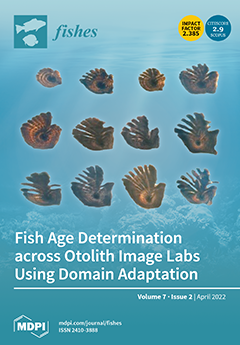Aquaporins (AQPs) play crucial roles in osmoregulation, but the knowledge about the functions of AQPs in
Sinonovacula constricta is unclear. In this study,
Sc-AQP1,
Sc-AQP8, and
Sc-AQP11 were identified from
S. constricta, and the three
Sc-AQPs are highly
[...] Read more.
Aquaporins (AQPs) play crucial roles in osmoregulation, but the knowledge about the functions of AQPs in
Sinonovacula constricta is unclear. In this study,
Sc-AQP1,
Sc-AQP8, and
Sc-AQP11 were identified from
S. constricta, and the three
Sc-AQPs are highly conserved compared to the known
AQPs. The qRT-PCR analysis revealed that the highest mRNA expressions of
Sc-AQP1,
Sc-AQP8, and
Sc-AQP11 were detected in the gill, digestive gland, and adductor muscle, respectively. In addition, the highest mRNA expression of
Sc-AQP1 and
Sc-AQP11 was detected in the D-shaped larvae stage, whereas that of
SC-AQP8 was observed in the umbo larvae stage. The mRNA expression of
Sc-AQP1,
Sc-AQP8, and
Sc-AQP11 significantly increased to 12.45-, 12.36-, and 27.44-folds post-exposure of low salinity (3.5 psu), while only
Sc-AQP1 and
Sc-AQP11 significantly increased post-exposure of high salinity (35 psu) (
p < 0.01). The fluorescence in situ hybridization also showed that the salinity shift led to the boost of
Sc-AQP1,
Sc-AQP8, and
Sc-AQP11 mRNA expression in gill filament, digestive gland, and adductor muscle, respectively. Knockdown of the
Sc-AQP1 and
Sc-AQP8 led to the decreased osmotic pressure in the hemolymph. Overall, these findings would contribute to the comprehension of the osmoregulation pattern of AQPs in
S. constricta.
Full article





